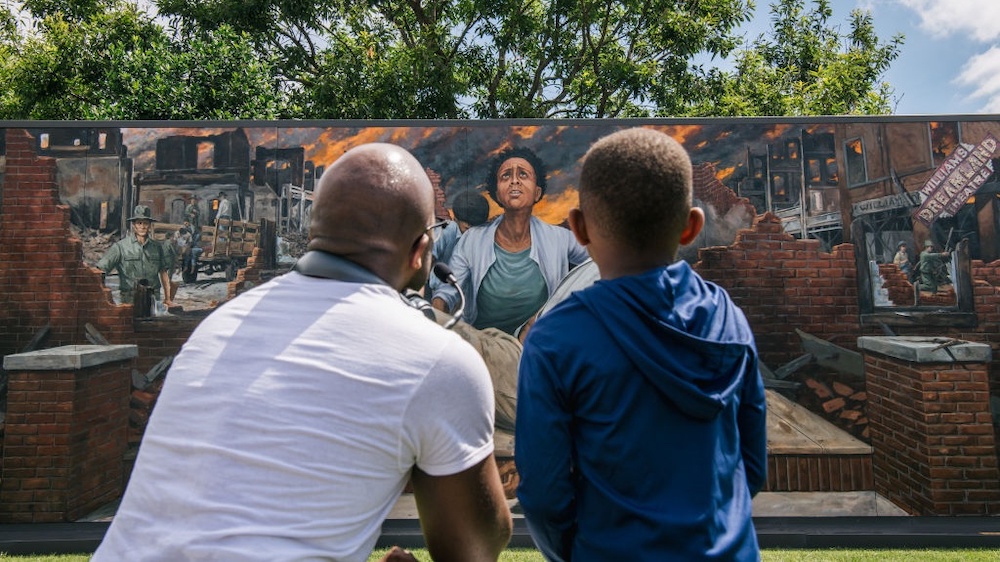If you’re interested in sharing your opinion on any cultural, political or personal topic, create an account here and check out our how-to post to learn more.
Opinions are the writer’s own and not those of Blavity's.
____
For the 100-year commemoration of the 1921 Tulsa Race Massacre, maestra, a black-female owned creative social impact agency, curated spaces and places to pay homage to the descendants of Black Wall Street, educate storytellers on the history of the Greenwood District, and to create momentum around the future movement and economic growth of the Greenwood District and beyond. After that incredibly formative experience, I was left with this conviction.
James Baldwin said, “To be a Negro in this country and to be relatively conscious is to be in a rage almost all the time.”
One hundred years after the Tulsa Race massacre, I ask myself, how have our emotions evolved from rage, or have they?
I sit in John Hope Reconciliation Park interrogating this question, but I struggle to hear my own thoughts over the noisy muffle and shifty vibration of the freeway almost directly above me. 50 years after the fire, blood and robbery of the massacre, Interstate 244 still managed to force its way through the revitalized and rebuilt Black Wall Street. The presence of this freeway makes me feel uneasy.
Sitting in this discomfort, a familiar sensation comes over me. I begin to reminisce on the pressures my ancestors must have felt when they and scores of African Americans moved from the north to the south during the Great Migration. My great grandmother, Annabelle Rideaux, traveled from Birmingham, Alabama, to St. Paul, Minnesota, in the 1920s to escape Jim Crow racism and seek economic opportunity. The forced movement of our people is a historical trend that isn’t acknowledged enough.
How many Black families' legacies have been broken apart by forced movement?
Secretary of Transportation Pete Buttigieg has acknowledged how federally funded highways have sliced through neighborhoods of color, displacing residents and slashing the home values of those who managed to remain. In Tulsa, urban renewal — which descendants of Greenwood more accurately describe as “urban removal” sparked Black Wall Street's second destruction.
Frustrated, I stare at the crashing waterfall at the entrance of the park. The last time I visited, I was on a tour guided by Vanessa Adams Harris, who leads outreach and alliances for The John Hope Franklin Center for Reconciliation, where she trains community members to become docents discussing the 1921 Tulsa Race Riot and Massacre and the history of African American and Native peoples in Oklahoma.
As the waterfall crashed against the surface of the marble fountain, Harris explained that the rushing cascade was strategically placed at the front of the park as an attempt to drown out the disturbing noise of the highway. Wishful thinking. The reality is the waterfall could never solve the burden that the sheer presence of the freeway represents for the descendants of Greenwood, let alone quiet the noise.
What does it look like to dismantle the system that has oppressed generations?
My mind races and I recognize that being on Black Wall Street I am moved to push farther, to climb higher, to believe bigger. Maybe it’s the spirit of the ancestors, or their remembrance, or maybe it’s the acknowledgment of the resilience and hope of the descendants who have built and rebuilt and sustained their families, businesses and legacies in the face of oppression. Or maybe it’s because in them I feel called to embrace my great grandmother who traveled from Birmingham, Alabama, to St.Paul, Minnesota, only to be forcibly removed from her home when the government made the decision to build a freeway through St. Paul’s most thriving Black community, Rondo.
From 1956 to 1968, by way of the Federal Aid Highway Act, dozens of communities across the country were forced to move at the hands of the federal and state government. Therefore another example of intentional destruction, violence and forced movement of Black communities. Quite the irony — forcing Black people to move in order to transport white agendas.
To where are the people on the highways traveling and how many other ways could they get to their destination?
Forceful removal from land — designed as legislation, treaties or other policies — is a practice that has been common in the United States since its inception. Every day, the burden of this responsibility — to be aware, to dismantle, to disrupt — feels heavier. However, while on Black Wall Street, the essence of my Blackness interrogates me at the deepest level. I revisit the question that Vanessa Adams Harris asked us on the tour: “How do you grapple with the painful harm done by the oppressor?”
Emotionally exhausted from the mental and spiritual labor that went into re-processing all that my ancestors of the Greenwood District were, are, and continue to be 100 years after the Tulsa Race Massacre, I realize this feeling is much more complex than rage. I sit in these feelings waiting for the clarity of my own sentiments.
Finally, the presence of my ancestors resting inside of me speaks. “Beyond rage,” they whisper, “it’s responsibility, it’s liberation and it’s legacy. Keep building.”
This affirmation is all I need. For them, I will continue to seek understanding rather than to be understood.
